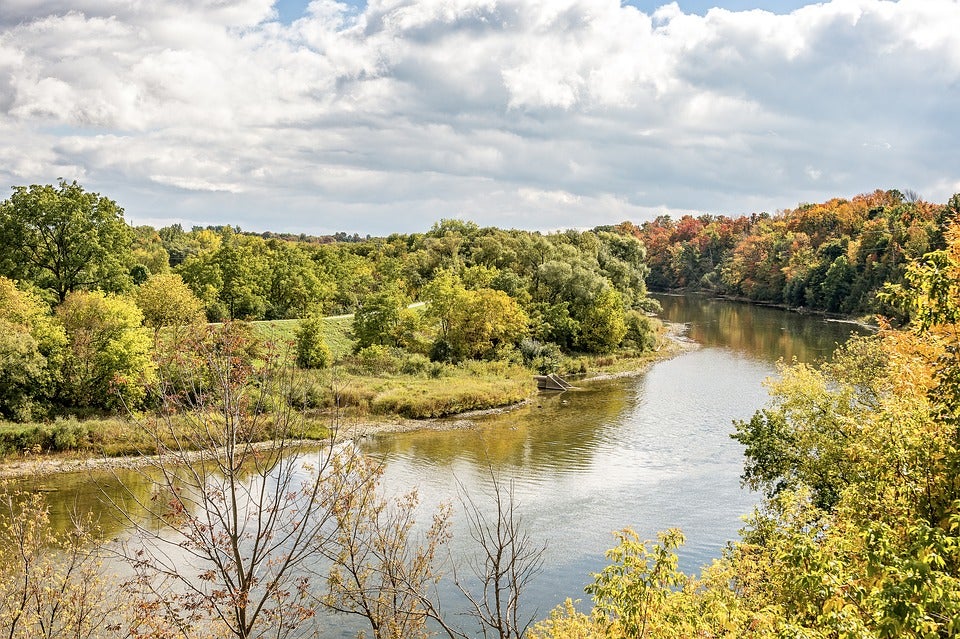Professor Mark Servos, Canada Research Chair in Water Quality Protection and professor of Biology, Nandita Basu, professor in the Departments of Earth and Environmental Sciences and Civil and Environmental Engineering, and post-doctoral fellow, Kim Van Meter, were prominently featured in Kitchener-Waterloo’s local newspaper. The story, which appeared on the front page of The Record on Saturday, December 2, included the expert opinions of these Water Institute members on water quality issues related to the Grand River.
The Grand River flows 300 kilometres through southwestern Ontario from the highlands of Dufferin County to Port Maitland on Lake Erie. It is a haven that attracts thousands of visitors on weekends to places like Elora Gorge and Glen Morris. It's a recognized national heritage river that is home to bald eagles, sandhill cranes, green herons, and prized sport fish such as steelhead and smallmouth bass.

But the Grand River will face a number of serious challenges in the upcoming years.
The watershed has a population of approximately one million people, and all leave their mark on the river. Twice a year, the Ancient Mariners canoe club of Cambridge organizes a cleanup of the Grand River. They regularly pull out 75-80 bags of garbage, everything from tangles of fishing line, chunks of Styrofoam, plastic water bottles, old tires and grocery carts.
However, the population pressures on the Grand extend well beyond concerns about litter. More people mean more demands for drinking water, and more toilets flushing, which means more treated sewage eventually making its way into the Grand.
Upgrading wastewater treatments plants
In 2011, the region invested hundreds of millions of dollars in improvements at the Region of Waterloo’s two largest sewage treatment plants in Kitchener Waterloo. The work has already led to dramatic improvements in the health of the Grand River, including a major reduction in the number of intersex fish.

Before the upgrades, the estrogen from birth control pills and chemicals that mimic natural hormones were making their way into the river, causing male rainbow darter fish to develop female traits, according to a study by Water Institute member Mark Servos. Concentrations were so high that in some areas, every male fish sampled in Servos' research showed some female traits. Immediately after the plants were upgraded, the proportion of intersex males dropped from 100 per cent in some areas, to 29 per cent. Within three years, it dropped below 10 per cent.
The major investments in wastewater treatment have led to dramatic improvements in the health of fish in the river.
Nancy Kodousek, director of water services for the Region of Waterloo, predicts even better water quality to come. "We're still only halfway through our treatment upgrades. By 2019 we'll see further improvements.”
Pressures from farmland
Most of the Grand River’s journey is through farmland. As the river flows downstream, manure and fertilizer from farm run-off enter the river, leading to overgrowths of algae, which consume oxygen in the water, killing off fish, plants and other species.

Water
Institute
member,
Nandita
Basu,
and
Kim
Van
Meter,
a
post-doctoral
fellow
in
Waterloo’s
Department
of
Earth
and
Environmental
Sciences,
looked
at
more
than
50
years'
of
data
on
the
Grand
River
and
found
that
better
farming
practices
and
new
crop
varieties
have
led
to
bigger
harvests,
without
increasing
fertilizer
use.
We are using the same amount of fertilizer, but our crop yields have increased. The fertilizer is being applied more efficiently, so in many areas less is making its way to the streams.
According to Basu and Van Meter, these improvements, however, can take years, or even decades to translate to better water quality.
Working towards a common goal
The Grand is a unique place, in terms of the commitment to work together. It's one of a kind. I have been in other watersheds in other parts of the world that are more vulnerable than the Grand, and you don't see that level of co-operation.